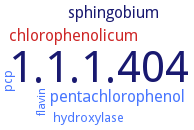1.1.1.404: tetrachlorobenzoquinone reductase
This is an abbreviated version!
For detailed information about tetrachlorobenzoquinone reductase, go to the full flat file.

Word Map on EC 1.1.1.404 
-
1.1.1.404
-
sphingobium
-
chlorophenolicum
-
pentachlorophenol
-
pcp
-
hydroxylase
-
flavin
- 1.1.1.404
-
sphingobium
- chlorophenolicum
- pentachlorophenol
- pcp
- hydroxylase
- flavin
Reaction
Synonyms
2,3,5,6-tetrachlorobenzoquinone reductase, PcpD, TCBQ reductase
ECTree
Advanced search results
General Information
General Information on EC 1.1.1.404 - tetrachlorobenzoquinone reductase
Please wait a moment until all data is loaded. This message will disappear when all data is loaded.
metabolism
-
the enzyme participates in the degradation of pentachlorophenol
physiological function
a mutant strain lacking functional PcpD has an impaired ability to remove pentachlorophenol from the medium but removes tetrachlorophenol from the medium at the same rate as does the wild-type strain
physiological function
TCBQ reductase is the second enzyme in the pentachlorophenol degradation pathway. It rescues the nonproductive diradical complex generated by pentachlorophenol hydroxylase via two fast sequential one-electron transfers
physiological function
tetrachlorohydroquinone reductase PcpD catalyzes the reduction of tetrachlorohydroquinone to tetrachlorohydroquinone. In the presence of PcpD, tetrachlorohydroquinone formed by pentachlorophenol hydroxylase PcpB is sequestered until it is reduced to the less toxic tetrachlorohydroquinone, protecting the bacterium from the toxic effects of tetrachlorohydroquinone and maintaining flux through the pathway. Deletion of pcpD results in increased sensitivity to phenols that are degraded via a benzoquinone intermediate
physiological function
-
a mutant strain lacking functional PcpD has an impaired ability to remove pentachlorophenol from the medium but removes tetrachlorophenol from the medium at the same rate as does the wild-type strain
-


 results (
results ( results (
results ( top
top






